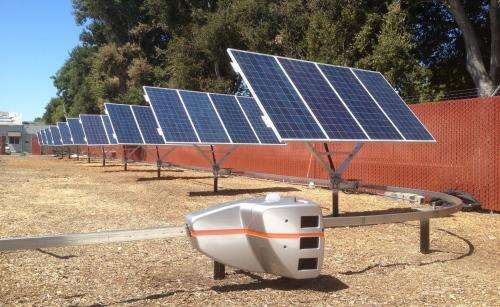Credit: QBotix
(Phys.org)—As prices for solar panels continue to fall, those looking to make money selling large arrays have increasingly been turning their attention to the physical infrastructure that supports the panels. To keep the panels pointing at the sun, engineers typically install motors, gears and electronic controllers on each one, all of which tend to cost a lot of money. Buyers on the other hand must make decisions on whether to install arrays with no moving capabilities or to choose from either single our double axis systems, with the latter costing a lot more. Single axis systems are capable of tilting panels along one line, moving forward following the available sunlight. Those with a two axis tracker on the other hand can tilt sideways a little bit as they move forward to ensure the panels face directly into the sun. Now, a new startup called QBotix has come up with what it believes is a better way. They employ a small robot moving on a monorail to move between the panels adjusting each to point at the sun, eliminating the need for each panel to have its own motors, gears or electronics.
The company says it can build a two axis array for the price of a single axis system using its QBotix Tracking System (QTS) giving customers up to fifteen percent more energy capture over existing single axis systems.
The QTS consists of two small battery operated robots that trade off adjusting duties. One moves along its monorail, stopping at each panel to adjust its tilt, up to 200 in just forty minutes, which is the time it takes for the sun to move ten degrees, while the other recharges. While it's making its adjustments the robot also retrieves data from each panel and sends it wirelessly to a server to monitor its health. And because the robot moves on a monorail, the makers say it can allow for panel arrays to be built on land that's not flat or even smoothed out. Also, to save costs, the electrical wiring for the panels can be housed with the monorail, saving digging and inspection costs.
QBotix has been testing an installed system for nearly a year and has raised seven and a half million dollars thus far and says that it has its first customer already lined up and will begin installation later this month. They say their QTS can also be used to direct sunlight to boiler systems that generate electricity from steam.
© 2012 Phys.org























